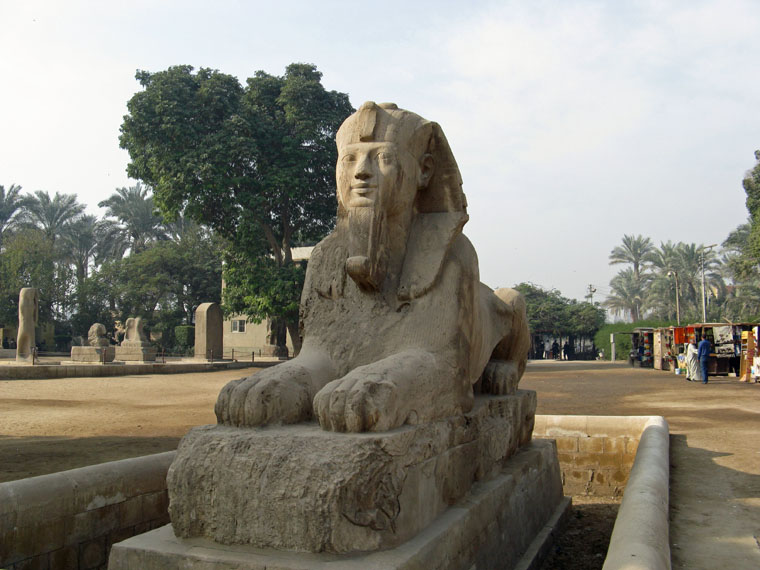The Egyptian sphinx
In ancient Egypt, the sphinx was a mythical creature associated with kings, as well as divinities (in particular the sun god). They often served as guardians, such as the Great Sphinx on the Giza plateau, which is located next to the causeway of the pyramid belonging to King Khafra (r. 2558–2532 BC). The head of the Great Sphinx may even have been modelled after Khafra.
Egyptian sphinxes have the body of a lion and the head of a man. The head typically features the nemes, the royal headcloth, as well as the royal beard typical of Egypt’s rulers and the uraeus, a piece of head ornamentation in the form of a stylized cobra. You’ve probably seen these elements before, for example on the famous mask of Tutankhamun.
When I was Egypt, a few years ago, I took this picture at the archaeological site of Memphis (near Cairo) of a sphinx that dates back to the reign of Ramesses the Great (r. 1279–1213 BC). The face was probably modelled after the king; note the royal beard and uraeus:

While most surviving statues of sphinxes are very large, smaller statues of sphinxes were used to line the roads leading to a temple from at least the New Kingdom period onwards (after ca. 1550 BC). Two-dimensional images of sphinxes were used to decorate jewellery or shields. Because of their associations with kings and the sun-god, they are nearly always found in places and on objects associated with kings and temples.
The modern word ‘sphinx’ itself derives from the Greek, which in turn may have been adopted from the Egyptian shesep ankh, which means ‘living image’. However, the Greek sphinx is completely different from the Egyptian one. The Greek version still has the body of a lion and head of a human, but it is invariably female and usually winged. Unlike the Egyptian sphinx, the Greek creature is a monster that, in the story of Oedipus, torments visitors and inhabitants of Thebes by posing a riddle, devouring those who failed to solve it correctly.
The Greeks undoubtedly took the sphinx from ancient Egypt. There are depictions of sphinxes on Mycenaean objects that date back to the Late Bronze Age, so synchronous with Egypt’s New Kingdom and well after the age of the Great Sphinx. These already feature female, winged sphinxes, although it’s not apparent from the images themselves if they were already considered monstrous or not by the Mycenaean Greeks.
An even bigger mystery, of course, is why this Egyptian benevolent guardian changed into a monster among the ancient Greeks. Most likely, Greeks had only seen images of the creature (or perhaps even just heard descriptions) and then let their imaginations run wild. As with so many things from the ancient world, we may never know for sure.

